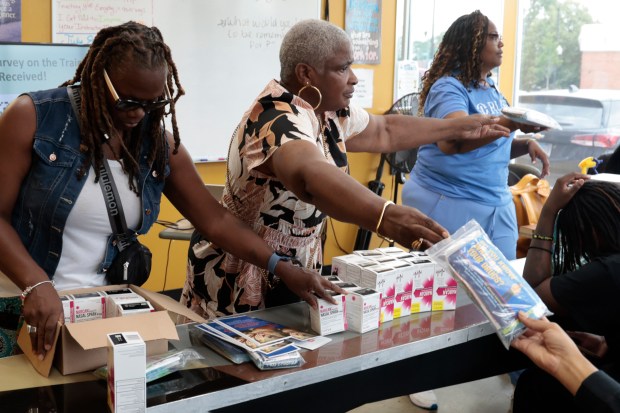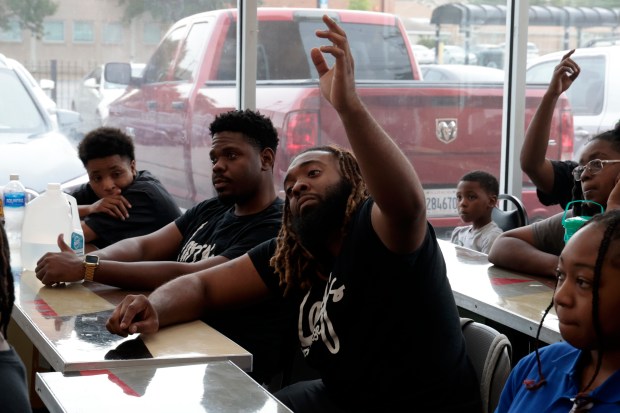A social worker and nurse practitioner demonstrated how to administer Narcan nasal spray — a potentially life-saving treatment during an opioid overdose — to a classroom of more than a dozen barber college students on the city’s South Side on Tuesday.
It was part of an initiative by Rush University Medical Center to help combat the opioid crisis in typically underserved communities.
While the students aren’t training to be health care workers or medical providers, the next generation of barbers and hair stylists are uniquely poised to disseminate information about substance use disorders to their clients as well as administer Narcan to reverse an opioid overdose in the event of an emergency, said Keisha House, a nurse practitioner and assistant director of Rush’s Substance Use Disorder Center of Excellence.
“You all are our eyes and ears, in the barbershop,” House told the audience at Larry’s Barber College in the Washington Park neighborhood, during a presentation on substance use disorders just before the Narcan demonstration.
An opioid overdose in real life looks very different from what’s often portrayed on television and in movies, she explained to the students. Symptoms can include unresponsiveness, constricted pupils, a limp body and breathing that slows or stops, according to the Chicago Department of Public Health.
House said there’s no stereotypical or textbook individual who struggles with use disorders, adding that people “have been using drugs since the beginning of time.” She noted that substance use disorders can include illicit drugs as well as prescription medication.
Opioid overdose deaths have risen dramatically nationwide in recent years, from a little over 21,000 in 2010 to nearly 50,000 in 2019 to just over 81,800 in 2022, according to Centers for Disease Control and Prevention statistics.
In Illinois, opioid overdoses have increased more than 8% from 2021 to 2022; in 2022, there were 3,261 opioid fatalities — more than twice the number of car accident deaths and homicides, according to Illinois Department of Public Health data. State health department officials attribute the rise in opioid overdose fatalities to the increase of synthetic opioids, such as fentanyl.
Naloxone — the generic name for the brand-name product Narcan — can reverse the effects of an opioid overdose, if administered right away. The nasal spray medication was approved for over-the-counter use by the Food and Drug Administration in 2023; it works on overdoses in street drugs, including fentanyl and heroin, as well as prescription versions, such as oxycodone.
While House noted that all types of people grapple with substance use disorders — which span different ages, education levels, races and backgrounds — opioid overdose deaths tend to disproportionally impact Black and brown neighborhoods.
In 2018, Chicago residents who died from an opioid-related overdose lived all across the city, according to the Chicago Department of Public Health’s 2018 Opioid Overdose Surveillance report; but the neighborhoods with the most fatalities were Austin, Humboldt Park and North Lawndale, all areas with predominantly Black and Latino populations.
Emergency officials responded to opioid overdoses in all city neighborhoods in 2018, but most frequently to Austin, Humboldt Park and West Garfield Park. These three communities accounted for over 30% of all emergency medical services overdose responses, the report said.
House said the problem is often compounded by a dearth of health care infrastructure in Black and brown neighborhoods, as well as a prevalent mistrust of medical providers in these communities due to historical abuses.
“A lot of what African Americans know about health is from negative experiences,” she said. “If we can educate our stylists, they can help change some of these negative perceptions in the health care industry so people can get help.”
House said she’s spoken at several barber colleges recently and plans to give similar presentations at beauty salons as well. The center at Rush is also working with churches and faith groups to bring these kinds of demonstrations to religious spaces.
Health officials around the country have turned to hair salons and barber shops to help combat public health epidemics in the past, from tackling vaccine hesitancy during the COVID-19 pandemic to promoting education about health problems such as HIV, diabetes and high blood pressure.
In 2017, a new Illinois law required hair stylists, barbers, cosmetologists and certain other professions to receive domestic violence and sexual assault awareness training, enlisting them to help prevent these kind of abuses. While the legislation doesn’t require these workers to report violence, advocates cited the close relationship between many clients and their hair stylists or cosmetologists, potentially offering one more avenue of help for assault or abuse survivors.
“In the beauty shop, barber shop, it’s a safe haven,” House said. “If we increase the knowledge, the training, the awareness … we’re able to promote positive health behaviors among their customers, where they feel safe.”
Part of her message includes challenging the stigma that often surrounds substance use disorders.
“A lot of people who have developed use disorders and addictions, they’re looking for a way out of being in pain,” she said. “Whether it’s pain from trauma, from emotions, from mental illness or pain in their bodies. Maybe they have chronic pain — arthritis or fibromyalgia or rheumatoid arthritis, sickle cell disease. A lot of times people are trying to avoid pain, in the mind or in the body, and they turn to substances. Or they were using a substance to help and developed a dependence and a tolerance — and later an addiction.”

Across the Chicago area, public health officials have been testing novel ways to make naloxone more accessible.
South suburban officials announced in May that a vending machine at the Pace Harvey bus terminal will provide free Narcan kits. Last year, the Oak Park Department of Public Health added publicly accessible boxes with naloxone at various intersections in the village, part of an “Opioid Overdose Prevention Project.”
Narcan is also available for free in all public libraries in Chicago, and the Chicago Department of Public Health trains librarians on opioid overdose prevention and how to use naloxone.
After the presentation at Larry’s Barber College, the students were given Narcan kits to take with them.
Some participants expressed unease or hesitancy at the prospect of administering naloxone during an emergency.
But 30-year-old Laniah Davis said she felt ready to do so after watching the demonstration and presentation.
“Now that we know this information, we’re able to save a life or two,” she said. “And we can pass it along to other people to save lives.”
She added that she’s “always been the type of person to jump into action.”
“If it was somebody in my family, I would want someone to help them,” she said. “So whether I know them or not … I would see myself jumping into action to do whatever it takes.”
eleventis@chicagotribune.com



